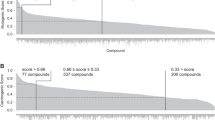Abstract
This assessment focuses on the concentrations of some chemicals present in theAgaricus bisporus mushroom, the cancer-inducing doses of these chemicals or mushroom used in the animal experiments, the total amounts of these chemicals or mushroom needed to induce cancer in these mice, and the estimated total amounts of these chemicals or mushroom needed to induce cancer in humans. By adding the estimated amounts of chemicals needed to induce cancer and by comparing it with the amount of raw mushroom needed to induce the same effect, it becomes obvious that we have accounted for less than 2% of the carcinogenic components of theAgaricus bisporus mushroom. Since some unavailable data handicapped this assessment, it should be regarded as tentative and subject to further adjustment.
Similar content being viewed by others
References
Levenberg B. Structure and enzymatic cleavage of agaritine, a phenylhydrazide of L-glutamic acid isolated from Agaricaceae. J Am Chem Soc 1961; 83: 503–4.
Levenberg B. An aromatic diazonium compound in the mushroomAgaricus bisporus. Biochim Biophys Acta 1962; 63: 212–14.
Kelly RB, Daniels EG, Hinman JW. Agaritine: Isolation, degradation and synthesis. J Org Chem 1962; 27: 3229–31.
Levenberg B. Isolation and structure of agaritine, a γ-glutamyl-substituted arylhydrazine derivative from Agaricaceae. J Biol Chem 1964; 239: 2267–73.
Ross A, Nagel D, Toth B. Occurrence, stability and decomposition of β-N[γ-L(+)glutamyl]-4-hydroxymethylphenylhydrazine (agaritine) from the mushroomAgaricus bisporus. Food Chem Toxicol 1982; 20: 903–7.
Ross AE, Nagel D, Toth B. Evidence for the occurrence and formation of diazonium ions in theAgaricus bisporus mushroom and its extracts. J Agric Food Chem 1982; 30: 521–25.
Liu JW, Beelman RB, Lineback DR, Speroni JJ. Agaritine content of fresh and processed mushrooms [Agaricus bisporus (Lange) Imbach]. J Food Sci 1982; 47: 1542–48.
Speroni JJ, Beelman RB. High performance liquid chromatographic determination of agaritine in cultivated mushrooms. J Food Sci 1982; 47: 1539–41.
Speroni JJ, Beelman RB, Schisler LC. Factors influencing the agaritine content in cultivated mushrooms,Agaricus bisporus. J Food Protect 1983; 46: 506–13.
Fisher B, Luthy J, Schlatter C. Gehaltsbestimmung von Agaritin in Zuchtchampignon (Agaricus bisporus) mittels Hochleistungflüssigchromatographic (HPLC). Z Lebenam Unters Forsch 1984; 179: 218–23.
Chauhan Y, Nagel D, Issenberg P, Toth B. Identification ofp-hydrazinobenzoic acid in the commercial mushroomAgaricus bisporus. J Agric Food Chem 1984; 32: 1067–69.
Chauhan Y, Nagel D, Gross M, Cerny R, Toth B. Isolation of N2-[γ-L(+)-glutamyl]-4-carboxyphenylhydrazine in the cultivated mushroomAgaricus bisporus. J Agric Food Chem 1985; 33: 817–20.
Stijve T, Fumeaux R, Philippossian G. Agaritine, ap-hydroxymethylphenylhydrazine derivative in cultivated mushrooms (Agaricus bisporus), and in some of its wild-growing relatives. Deut Lebensm-Rundsch, 1986; 82: 243–48.
Toth B, Raha CR, Wallcave L, Nagel D. Attempted tumor induction with agaritine in mice. Anticancer Res 1981; 1: 255–58.
Toth B, Sornson H. Lack of carcinogenicity of agaritine by subcutaneous administration in mice. Mycopathology 1984; 85: 75–9.
Toth B, Nagel D, Patil K, Erickson J, Antonson K. Tumor induction with the N′-acetyl derivative of 4-hydroxymethylphenylhydrazine a metabolite of agaritine ofAgaricus bisporus. Cancer Res 1978; 38: 177–80.
Toth B, Patil K, Jae HS. Carcinogenesis of 4-(hydroxymethyl)benzenediazonium ion (tetrafluoroborate) ofAgaricus bisporus. Cancer Res 1981; 41: 2444–9.
Toth B, Nagel D, Ross A. Gastric tumorigenesis by a single dose of 4-(hydroxymethyl)benzenediazonium ion ofAgaricus bisporus. Br J Cancer 1982; 46: 417–22.
Toth B, Erickson J. Cancer induction in mice by feeding of the fresh uncooked cultivated mushroom of commerceAgaricus bisporus. Cancer Res 1986; 46: 4007–11.
Toth B. Carcinogenesis by N2-[γ-L(+)-glutamyl]-4-carboxyphenylhydrazine ofAgaricus bisporus in mice. Anticancer Res 1986; 6: 917–20.
Toth B. Cancer induction by sulfate form of 4-(hydroxymethyl) benzenediazonium ion ofAgaricus bisporus. In Vivo 1987; 1: 39–42.
McManus BM, Toth B, Patil K. Aortic rupture and aortic smooth muscle tumors in mice: induction byp-hydrazinobenzoic acid hydrochloride of the cultivated mushroomAgaricus bisporus. Lab Invest 1987; 57: 78–85.
Toth B. Carcinogenic fungal hydrazines. In Vivo 1981; 5: 95–100.
LaRue TA. Naturally occurring compounds containing a nitrogen-nitrogen bond. Lloydia 1977; 40: 307–21.
Schütte HR, Liebisch HW, Miersch O, Senf L. Untersuchungen zur Biosynthese des Agaritins inAgaricus bisporus. Ann Quimica 1972; 68: 899–903.
Gannett PM, Toth B. Heat sensitivity of chemicals of theAgaricus bisporus (AB) mushroom. Proc Am Assoc Cancer Res 1991; 32: 116.
Hashida C, Hayashi K, Jie L, Haga S, Sakurai M, Shimizu H. Quantities of agaritine in mushrooms (Agaricus Bisporus) and the carcinogenicity of mushroom methanol extracts on the mouse bladder epithelium. Jap J Publ Health, 1990; 37: 400–5.
Author information
Authors and Affiliations
Rights and permissions
About this article
Cite this article
Toth, B., Gannett, P. Agaricus Bisporus: An assessment of its carcinogenic potency. Mycopathologia 124, 73–77 (1993). https://doi.org/10.1007/BF01103105
Received:
Accepted:
Issue Date:
DOI: https://doi.org/10.1007/BF01103105




